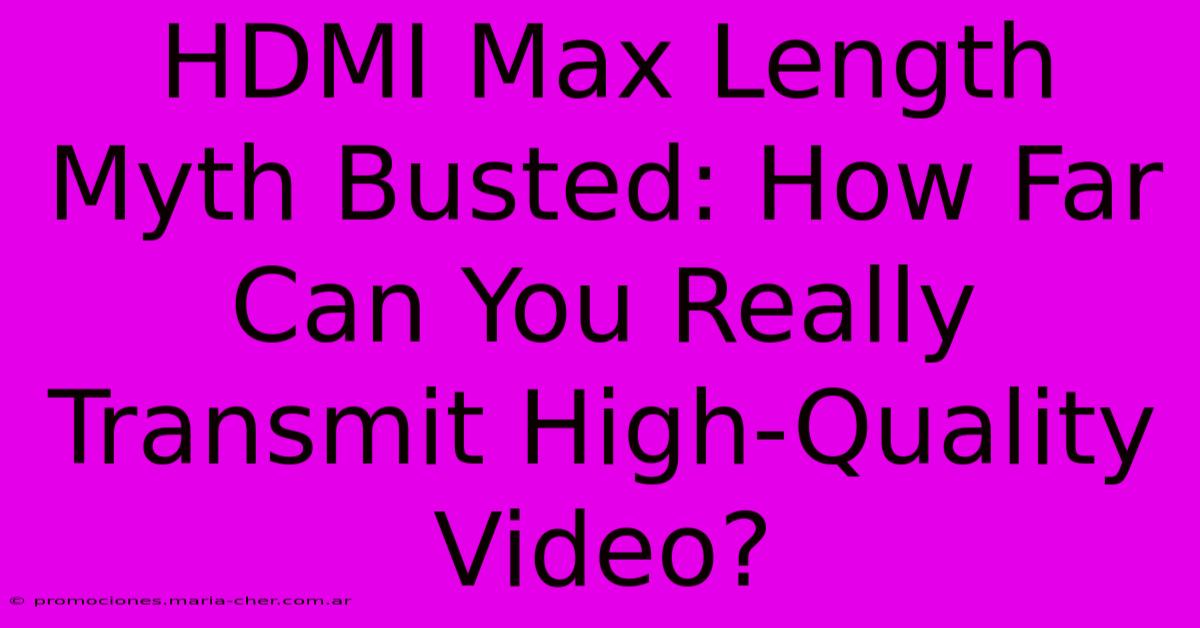HDMI Max Length Myth Busted: How Far Can You Really Transmit High-Quality Video?

Table of Contents
HDMI Max Length Myth Busted: How Far Can You Really Transmit High-Quality Video?
The age-old question for home theater enthusiasts and AV professionals alike: What's the maximum HDMI cable length? The internet is rife with misinformation, claiming arbitrary limits like 50 feet. But the truth is far more nuanced. This article will debunk the HDMI max length myth and reveal how you can successfully transmit high-quality video over significantly longer distances.
Understanding the HDMI Distance Limitation
The common misconception stems from a misunderstanding of HDMI's signal characteristics. Standard HDMI cables, particularly those labeled "High-Speed" or "Standard Speed", struggle to maintain signal integrity beyond relatively short distances. This isn't because of a hard limit imposed by the HDMI standard itself, but because of signal attenuation. As the signal travels along the cable, it weakens, leading to signal loss and potentially resulting in:
- Poor image quality: Blurriness, pixelation, and color distortion.
- Audio dropouts: Intermittent loss of sound.
- No signal: Complete failure of the connection.
Factors Affecting HDMI Signal Transmission Distance
Several factors influence how far a high-quality HDMI signal can travel:
- Cable quality: Cheap cables use inferior materials and construction, leading to higher signal attenuation. High-quality HDMI cables with proper shielding and thicker conductors are crucial for longer distances.
- HDMI version: Newer HDMI versions (like HDMI 2.1) generally handle higher bandwidths, but this doesn't inherently extend the distance. Signal attenuation still applies.
- Resolution and refresh rate: Higher resolutions (like 4K) and refresh rates (like 120Hz) demand greater bandwidth, making them more susceptible to signal degradation over long distances.
- Cable type: Different cable types have varying signal transmission capabilities. Standard cables are suitable for shorter runs, while active HDMI cables and HDMI extenders are designed for longer distances.
Active vs. Passive HDMI Cables: A Crucial Distinction
This is where understanding the difference between passive and active HDMI cables becomes critical:
-
Passive HDMI cables: These are the standard cables you'll find everywhere. They simply transmit the signal without amplification. Suitable for short distances only.
-
Active HDMI cables: These incorporate built-in amplifiers to boost the signal, allowing for significantly longer transmission distances. This is the key to overcoming the perceived HDMI distance limitations. Look for cables explicitly designed for longer runs.
Extending HDMI Over Long Distances: Practical Solutions
So, how far can you go? With the right equipment, you can transmit high-quality HDMI signals over remarkably long distances. Here are the most effective solutions:
1. Active HDMI Cables:
These are the most straightforward solution for moderate distances (up to 100ft and sometimes beyond, depending on resolution and quality). Choosing an active cable specifically designed for your desired resolution and refresh rate is crucial.
2. HDMI Extenders:
For distances exceeding what active cables can manage, HDMI extenders are the best choice. These devices receive the HDMI signal at one end and transmit it over a longer distance using various methods (like fiber optic cables). They often offer features such as signal boosting and equalization. They're ideal for installations requiring extremely long cable runs, such as large commercial settings or dedicated home theaters.
3. HDMI over IP Systems:
These advanced systems transmit HDMI signals over a standard IP network (Ethernet). They're the ultimate solution for long distances and complex installations, offering flexibility and scalability. However, they typically represent a more expensive investment than active cables or extenders.
Conclusion: Busting the Myth
The maximum HDMI cable length isn't a fixed number. With the correct approach and the right technology – primarily active HDMI cables or HDMI extenders – you can easily extend the reach of your HDMI signal, even for high-resolution video sources. Don't let the myth of a 50-foot limit restrict your home theater setup or professional AV installation. Invest in quality components and choose a solution that fits your specific needs. Now you can enjoy high-quality video without compromising on distance.

Thank you for visiting our website wich cover about HDMI Max Length Myth Busted: How Far Can You Really Transmit High-Quality Video?. We hope the information provided has been useful to you. Feel free to contact us if you have any questions or need further assistance. See you next time and dont miss to bookmark.
Featured Posts
-
Beyond Branding Eli Lillys Logo As A Reflection Of Corporate Values
Feb 06, 2025
-
Glow Up With A Custom Face Mask Tailored To Your Skins Needs
Feb 06, 2025
-
Unveiling The Secrets Of Intimate Health Find The Best Gynecologist Near You
Feb 06, 2025
-
Wow Factor The Secret To Exceeding Customer Expectations
Feb 06, 2025
-
Progress Indicator 10s The Ultimate Tool For Website Optimization
Feb 06, 2025
